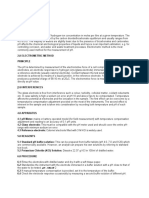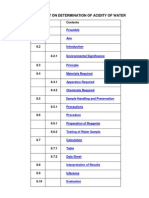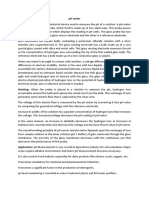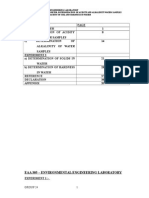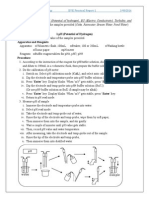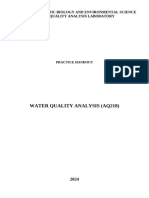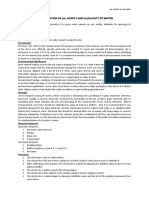WaterChemLabReport Grp4 CSE2
WaterChemLabReport Grp4 CSE2
Uploaded by
bmu2685Copyright:
Available Formats
WaterChemLabReport Grp4 CSE2
WaterChemLabReport Grp4 CSE2
Uploaded by
bmu2685Original Description:
Original Title
Copyright
Available Formats
Share this document
Did you find this document useful?
Is this content inappropriate?
Copyright:
Available Formats
WaterChemLabReport Grp4 CSE2
WaterChemLabReport Grp4 CSE2
Uploaded by
bmu2685Copyright:
Available Formats
Water Chemistry Lab Report
CSE2
Group No. 4
Suhani Aggarwal (230547) Harshit Khurana (230515)
Aastha Thakur (230552) Abhinav Singh (230528)
1. pH Measurement
Aim: Obtain an accurate pH measurement of a solution using a digital pH meter.
Procedure: Follow manual instructions to calibrate the pH meter, rinse the probe with distilled
water, submerge it into the solution, wait for a stable reading, and record the pH value.
Recorded Data: The pH of the solution was determined to be 7.5
Significance: A pH of 7.5 in water, slightly alkaline, sustains diverse aquatic life, has stable
buffering, meets drinking standards, and lowers plumbing corrosion risks. It reflects a beneficial
neutral to alkaline state for ecosystems and infrastructure.
2. Conductivity Test
Aim: Measure the conductivity of a water sample using a Conductivity Meter.
Procedure: Place the water sample in a clean container, submerge the conductivity probe
completely without touching the container's bottom or sides, wait for a stable reading, and record
the conductivity value.
Recorded Data: Normality of KCL = 0.1 g/l, Conductivity of KCL = 12.88 mS/cm.
Result: Conductivity of the observed water sample = 1.7 mS/cm.
Significance: A conductivity of 1.7 mS/cm signals low ion levels, indicating fairly pure
freshwater usable across many applications. It matches freshwater ecosystem norms and suits
industries needing low-conductivity water.
3. Turbidity
Aim: Measure turbidity of samples using a Nephelometer in NTU.
Procedure: Set the Nephelometer to 0 with distilled water, then to 100 with formazin
standard. Measure sample turbidity.
Result: Turbidity recorded as 0.07 NTU.
Significance: A turbidity of 0.07 NTU indicates minimal suspended particles, signifying clear
water crucial for drinking and ecosystems. Accurate nephelometer calibration ensures reliable
measurements, vital for monitoring water quality and regulatory compliance in various
environmental and industrial applications.
4. Total dissolved Solids
Aim: Determine the total dissolved solids (TDS) concentration in a sample.
Procedure: Measure initial flask weight, evaporate 20 mL of sample, measure final weight.
Calculate TDS using weight difference and sample volume.
Recorded Data:
Experimentally recorded data: 498ppm
Initial flask weight = 56.66 gm
Final Weight = 56.67 gm
TDS= change in weight/volume ⇒ (56.67-56.66)/20 mg/mL => 500 mg/L
Result: TDS concentration determined as 500 mg/L.
Significance: A TDS concentration of 500 mg/L indicates a moderate level of dissolved
substances in the water. This level is typically acceptable for drinking and irrigation purposes,
reflecting common mineral content in natural waters.
5. Dissolved Oxygen Level
Aim: Determine the dissolved oxygen (DO) concentration in the sample using the Winkler's
method (Azide modification).
Procedure: Mix 300 ml of water with 2 ml each of Manganous sulfate and alkali-iodide azide
reagent in a stoppered bottle. Add 3 ml concentrated Sulphuric acid, transfer 203 ml to an
Erlenmeyer flask, then titrate with sodium thiosulphate.
Recorded Data:
Reagent used: Alkali-Iodide azide
Indicator: Starch
Volume of (Sodium Thiosulphate) used = 3.4 ml
Calculations:
Formula used: DO(mg/L) = (8*1000*N*v)/V
here, N is normality of titrant
V is volume of sample taken
v is volume of titrant used
= (3.5*0.025*8*1000)/100 = 7 mg/L
Result: Dissolved oxygen measured at 7 mg/L.
Significance: A dissolved oxygen level of 7 mg/L in water signifies adequate oxygen for aerobic
organisms, supporting diverse aquatic life. It also indicates good water quality, suitable for
recreational activities like fishing and swimming, and can help maintain balanced ecosystems by
supporting natural processes like nutrient cycling and decomposition.
6. Biological Oxygen Demand at 5 (BOD)
Aim: Determine the biological oxygen demand exerted by a given sample.
Procedure : Dilute and pH-adjust a 100 ml sample to 500 ml. Add allylthiourea, phosphate
buffer, and incubate one bottle for 5 days at 27°C. Compare initial and final DO levels.
Recorded Data:
DO Initial = 7 mg/L
DO Final = (2.4*0.025*8*1000)/100 = 4.8 mg/L
BOD 5 = DO Initial - DO Final = 7 – 4.8 = 2.2 mg/L
Result: BOD was determined to be 2.2 mg/L
Significance: A BOD of 2.2 mg/L after 5 days indicates a relatively low level of organic
pollution in the water sample. This suggests good water quality with less organic material
present, which is beneficial for aquatic ecosystems and indicates a lower impact on oxygen levels
in the water body.
7. Total Hardness
Aim: Determine the total hardness of water samples using the EDTA titrimetric method .
Procedure: Mix 25 mL of the sample with distilled water to reach approximately 50 mL in an
Erlenmeyer flask. Introduce 1 mL of Buffer Solution and 2 drops of Eriochrome Black T
Indicator; observe the solution turning wine red. Gradually add standard EDTA titrant until the
reddish color shifts to blue, then record the EDTA volume used.
Recorded Data:
Hardness = V1 * N * Mr * 1000/V
Where, V1= Volume of EDTA added = 3.3 mL
N = Normality of the EDTA solution = 0.01 N
Mr = Molecular Weight of Calcium Carbonate = 100 amu
V = Volume of water taken = 25 mL
Hardness = 132 mg/L
Result: Total Hardness was measured to be 132 mg/L
Significance: A hardness level of 132 mg/L as Calcium Carbonate signifies moderately hard
water. This indicates notable mineral content, affecting taste and potentially requiring treatment
for industrial processes or managing scaling in pipes.
8. Alkalinity
Aim: Determine the alkalinity types in the provided sample
Procedure: In a clean flask, pour 25 mL of the sample. If residual chlorine is present, add 1 drop
of sodium thiosulphate solution. Add 2 drops of methyl orange indicator, resulting in an orange
solution. Titrate with standard sulphuric acid until the color shifts to wine red, and record the
volume of sulphuric acid used.
Recorded Data:
Alkalinity = V1 * N * Eq * 1000/25
V1 = Volume of sulphuric acid used = 5.5 mL
N = Normality of sulphuric acid solution = 0.01 N
Eq = Equivalent Weight of Calcium Carbonate = 100 g
V = Volume of water used = 25 mL
5.5*0.01*100*1000/25 = 220 mg/l.
Result: The alkalinity level is determined to be 220 mg/l.
Significance: A calcium carbonate alkalinity of 220 mg/L indicates high water buffering capacity
against pH changes. This is beneficial for ecosystems but may require attention in industrial or
treatment processes.
9. Chloride(Cl-) concentration determination
Aim: Determine chloride ion concentration in the water sample using Mohr’s Method.
Procedure: Mix 50 ml of water sample with 1 ml of Potassium Chromate, titrate with
standard silver nitrate until a reddish-brown precipitate forms. Note the volume as V1.
Recorded Data:
Chloride in mg/L = V1 * N * 35.46 * 1000/V
Where, V1 = Volume obtained after titration = 5.9 mL
N = Normality of the Silver Nitrate = 0.0141 N
V = Volume of the sample = 50mL
Now, Chloride in mg/l = 5.9 * 0.0141 * 35.46 * 1000/50
= 58.998348 = 59 mg/l
Result: Chloride ion concentration measured at 59 mg/L
Significance: A chloride concentration of 59 mg/L in water is safe for drinking, aligning with the
standard limit of around 60 mg/L. This indicates good water quality and minimal health risks
from chloride in drinking water.
CONCLUSION
Based on the data, the water appears to be of good quality, suitable for various purposes. It shows
a balanced pH, moderate conductivity, low turbidity, and acceptable levels of dissolved solids,
hardness, alkalinity, and chloride ions. The dissolved oxygen level suggests healthy aquatic
conditions with minimal organic pollution.
You might also like
- Payment ConfirmationDocument1 pagePayment ConfirmationBismark SarpongNo ratings yet
- Determination of Chemical Oxygen DemandDocument6 pagesDetermination of Chemical Oxygen DemandDani Mughal100% (1)
- Doc. Eddy Current Testing Basic PrincipleDocument43 pagesDoc. Eddy Current Testing Basic PrincipleCepi Sindang KamulanNo ratings yet
- Environmental LabDocument13 pagesEnvironmental Lab17GICIV0625.Mudasir Zaman AfridiNo ratings yet
- Enzyme-Technology-and-Biokinetics-Lab-Manual-BT-47L For Food LabDocument21 pagesEnzyme-Technology-and-Biokinetics-Lab-Manual-BT-47L For Food Labmasre semagnNo ratings yet
- CE18B005 BITTU Environmental Eng. Lab ReportDocument12 pagesCE18B005 BITTU Environmental Eng. Lab ReportNeerajNo ratings yet
- Priscilla Proposal For Chemistry STPM1-2Document4 pagesPriscilla Proposal For Chemistry STPM1-2SalinKaurNo ratings yet
- BOD & Acidity - 2022Document5 pagesBOD & Acidity - 2022Srijib HalderNo ratings yet
- No 3Document12 pagesNo 3Punit Ratna ShakyaNo ratings yet
- EE Lab Manual - 2019Document61 pagesEE Lab Manual - 2019Bony MathewNo ratings yet
- ENVIRONMENTAL EngineeringDocument16 pagesENVIRONMENTAL EngineeringSALMANNo ratings yet
- 09.11.2010 MethodologyDocument16 pages09.11.2010 MethodologyavvaimsvijayaNo ratings yet
- Exp 5 - PDF Acidity of WaterDocument14 pagesExp 5 - PDF Acidity of WaterYogendra PatilNo ratings yet
- Lab 1 AcidityDocument8 pagesLab 1 AcidityEngr Arafat QubatiNo ratings yet
- EE Experiments BTech 3rd Year 2023-24Document177 pagesEE Experiments BTech 3rd Year 2023-24Your FriendNo ratings yet
- Standard Analytical Procedures For Water AnalysisDocument80 pagesStandard Analytical Procedures For Water Analysismohamed samirNo ratings yet
- Lab Manual EE-IIDocument27 pagesLab Manual EE-IIKiran ShresthaNo ratings yet
- Determination of Alkalinity: Gargi Memorial Institute of TechnologyDocument2 pagesDetermination of Alkalinity: Gargi Memorial Institute of TechnologyswapnilNo ratings yet
- Standard Analytical ProceduresDocument80 pagesStandard Analytical Proceduresengr_afsoomro3147No ratings yet
- Environment Lab ManualDocument17 pagesEnvironment Lab ManualKamlesh GuptaNo ratings yet
- PH Metre, O2 and CO2 PracticalDocument4 pagesPH Metre, O2 and CO2 PracticalAfridi ShaikhNo ratings yet
- Lab Report ExampleDocument6 pagesLab Report Examplealiswheeler12No ratings yet
- Assignment 8Document4 pagesAssignment 8shuvobosu262No ratings yet
- ES252 Lab Manual (Spring 2022)Document40 pagesES252 Lab Manual (Spring 2022)Sumit kumar GuptaNo ratings yet
- Determination of Alkalinity in Given Water Sample: ObjectivesDocument8 pagesDetermination of Alkalinity in Given Water Sample: ObjectivesDani Mughal100% (2)
- 17-CE-158 (Lab Manual)Document36 pages17-CE-158 (Lab Manual)hamzahayatNo ratings yet
- Chen19112008 LabDocument25 pagesChen19112008 Labmuqadasameen44No ratings yet
- Acidity Test - Lec.Document10 pagesAcidity Test - Lec.Heba YousifNo ratings yet
- Chapter-3 Materials and MethodsDocument10 pagesChapter-3 Materials and MethodsNATIONAL XEROXNo ratings yet
- Physical Parameter TestDocument13 pagesPhysical Parameter TesteidalinNo ratings yet
- Watercolor Dental Clinic XL by SlidesgoDocument19 pagesWatercolor Dental Clinic XL by Slidesgotouseef125mNo ratings yet
- Lab Report-12: Environmental Chemistry (ENE-213) Course Instructor: Dr. Sofia BaigDocument6 pagesLab Report-12: Environmental Chemistry (ENE-213) Course Instructor: Dr. Sofia BaigHaniya SiddiqueNo ratings yet
- Determination of Total Alkalinity of Water SampleDocument6 pagesDetermination of Total Alkalinity of Water Sampleshaherbano Awan78% (9)
- Experiment No 7Document6 pagesExperiment No 7Anonymous WX5Thz7ENo ratings yet
- Ktu Chemistry Lab MANUALDocument47 pagesKtu Chemistry Lab MANUALjishnusaji100% (2)
- Dissolved OxygenDocument2 pagesDissolved OxygenSatya C U Srikanth100% (1)
- ION EXCHANGE Analysis Testing Procedures GeneralDocument50 pagesION EXCHANGE Analysis Testing Procedures GeneralJinalNo ratings yet
- LAB Manual EE1Document43 pagesLAB Manual EE1Khushi GuptaNo ratings yet
- Virtual Lab Experiment: Chemical AnalysisDocument5 pagesVirtual Lab Experiment: Chemical AnalysisAiron Fuentes EresNo ratings yet
- Fabusoro VictorDocument12 pagesFabusoro VictorharyodelekemisolaNo ratings yet
- Physical and Chemical Properties of The Surface Water Collected From Different Water SourcesDocument16 pagesPhysical and Chemical Properties of The Surface Water Collected From Different Water Sourcessaikatuser2003No ratings yet
- Experiment of Determination of PH, Solids and HardnessDocument39 pagesExperiment of Determination of PH, Solids and HardnessJohn Jhong0% (1)
- Practical Report-1 PH ValueDocument6 pagesPractical Report-1 PH ValueKusanSanjitNo ratings yet
- Environmental Engineering Manual: Prepared By: Mr. Sandeep Siwach Approved By: Dr. Arabinda SharmaDocument36 pagesEnvironmental Engineering Manual: Prepared By: Mr. Sandeep Siwach Approved By: Dr. Arabinda Sharmaamlmahmoudgad124No ratings yet
- Lab Report Environmental Engineering 2 (CEL304)Document40 pagesLab Report Environmental Engineering 2 (CEL304)Shivang KumarNo ratings yet
- SOP of WaterDocument7 pagesSOP of Wateranuj tyagiNo ratings yet
- Practice Handout AQ218 - 2024Document19 pagesPractice Handout AQ218 - 2024kemtrunghaNo ratings yet
- Lab Manual For IT (16 TH Dec)Document52 pagesLab Manual For IT (16 TH Dec)aattishNo ratings yet
- Sop-Sop-1 Water AnalysisDocument120 pagesSop-Sop-1 Water AnalysiskmsiddharthanNo ratings yet
- Lab 2Document6 pagesLab 2bed-che-40-21No ratings yet
- Methods of Sampling and Test (Physical and Chemical) For Water and Waste WaterDocument2 pagesMethods of Sampling and Test (Physical and Chemical) For Water and Waste WaterAnish kumarNo ratings yet
- QUALITY ANALYSI-WPS OfficeDocument5 pagesQUALITY ANALYSI-WPS OfficeMohan reddyNo ratings yet
- Expt 1Document5 pagesExpt 1RESHMYNo ratings yet
- Relazione AcquaDocument17 pagesRelazione AcquamalossigiulioNo ratings yet
- Advanced Pharmaceutical analysisFrom EverandAdvanced Pharmaceutical analysisRating: 4.5 out of 5 stars4.5/5 (2)
- The Chemistry of Fertilisers and Manure - Including Information on the Chemical Constituents and Types of Fertilisers and ManuresFrom EverandThe Chemistry of Fertilisers and Manure - Including Information on the Chemical Constituents and Types of Fertilisers and ManuresRating: 5 out of 5 stars5/5 (1)
- Practical Manual of Analytical ChemistryFrom EverandPractical Manual of Analytical ChemistryRating: 4.5 out of 5 stars4.5/5 (3)
- Standard methods for the examination of water and sewageFrom EverandStandard methods for the examination of water and sewageNo ratings yet
- Acid-Base and Electrolyte Handbook for Veterinary TechniciansFrom EverandAcid-Base and Electrolyte Handbook for Veterinary TechniciansAngela Randels-ThorpNo ratings yet
- Plant and Animal Bio-Chemistry - Including Information on Amino Acids, Proteins, Pigments and Other Chemical Constituents of Organic MatterFrom EverandPlant and Animal Bio-Chemistry - Including Information on Amino Acids, Proteins, Pigments and Other Chemical Constituents of Organic MatterNo ratings yet
- The Chemistry of Dairy Products - A Chemical Analysis of Milk, Cream and ButterFrom EverandThe Chemistry of Dairy Products - A Chemical Analysis of Milk, Cream and ButterNo ratings yet
- DDD - Assignment - BKC18368Document28 pagesDDD - Assignment - BKC18368Hieu DoNo ratings yet
- Connor Silva ResumeDocument1 pageConnor Silva Resumeapi-589152156No ratings yet
- OK-4919 Comparison and Price Table For Maerz® Lime Kilns: All Prices Given Are Budget Prices With An Accuracy of 20 %Document3 pagesOK-4919 Comparison and Price Table For Maerz® Lime Kilns: All Prices Given Are Budget Prices With An Accuracy of 20 %Guillermo E. ArenazaNo ratings yet
- Water PotentialDocument5 pagesWater PotentialTyrese BaxterNo ratings yet
- Esp32-H2 Datasheet enDocument43 pagesEsp32-H2 Datasheet enpetrusz1No ratings yet
- Nov 20 24 DLL MVD SCIENCE10Document5 pagesNov 20 24 DLL MVD SCIENCE10MARITES DURANGONo ratings yet
- KKP FullDocument18 pagesKKP FullYUSRI BIN KIPLI MoeNo ratings yet
- SECTION A: Write Number After: Fountain of Joy Nursery & Primary SchoolDocument12 pagesSECTION A: Write Number After: Fountain of Joy Nursery & Primary SchoolJeroboam MakuleNo ratings yet
- Priya Patel Vs State of M.P. & Anr On 12 July, 2006 PDFDocument4 pagesPriya Patel Vs State of M.P. & Anr On 12 July, 2006 PDFSandeep Kumar VermaNo ratings yet
- ATV/Motorcycle Computer: ACE-2XX User ManualDocument3 pagesATV/Motorcycle Computer: ACE-2XX User ManualtheunnoneNo ratings yet
- History Motorola Annual Report Archive 1965 5p14mb 28Document28 pagesHistory Motorola Annual Report Archive 1965 5p14mb 28markymarkNo ratings yet
- Parts 3120789 ANSI English PDFDocument346 pagesParts 3120789 ANSI English PDFMexanik212No ratings yet
- Dump Truck 740 CatDocument12 pagesDump Truck 740 Catkkmech100% (2)
- Royal College of Psychiatrists Rating Scales - With HyperlinksDocument6 pagesRoyal College of Psychiatrists Rating Scales - With Hyperlinksebadh100% (1)
- Vacuum DiagramsDocument14 pagesVacuum DiagramsAnimemanuel MuñozNo ratings yet
- Associated Press of PakistanDocument9 pagesAssociated Press of PakistanReemal KhanNo ratings yet
- A1 Feelings and Emotions Students WorksheetDocument6 pagesA1 Feelings and Emotions Students Worksheetelnaz.changizi1No ratings yet
- Argumentative Essay OutlineDocument3 pagesArgumentative Essay Outlineapi-547671509No ratings yet
- Unit 3 Lesson 1 The Cool School VocabularyDocument32 pagesUnit 3 Lesson 1 The Cool School Vocabularymylyn ortizNo ratings yet
- Hanson v. Tiger Supplies - ComplaintDocument29 pagesHanson v. Tiger Supplies - ComplaintSarah BursteinNo ratings yet
- Northwest Yachting (2014-01)Document116 pagesNorthwest Yachting (2014-01)mariaraquelsvm100% (1)
- Education LoanDocument2 pagesEducation LoanjaiNo ratings yet
- 2024 Grade 12 Geography Learner Last Push DocumentDocument80 pages2024 Grade 12 Geography Learner Last Push Documentnokubongadladla719No ratings yet
- AdverbsDocument7 pagesAdverbslatifa hachemiNo ratings yet
- STACCATO ESR Postions PDFDocument13 pagesSTACCATO ESR Postions PDFAnonymous KtAMdgNo ratings yet
- Integrated Converter With G2V V2G and DC V2V Charging Capabilities For Switched Reluctance Motor Drive-Train Based EV ApplicationDocument14 pagesIntegrated Converter With G2V V2G and DC V2V Charging Capabilities For Switched Reluctance Motor Drive-Train Based EV ApplicationhemaNo ratings yet
- The Labour Proclamation NoDocument15 pagesThe Labour Proclamation NoSosi SissayNo ratings yet
- 162322599388Document200 pages162322599388Annai FinanceNo ratings yet








